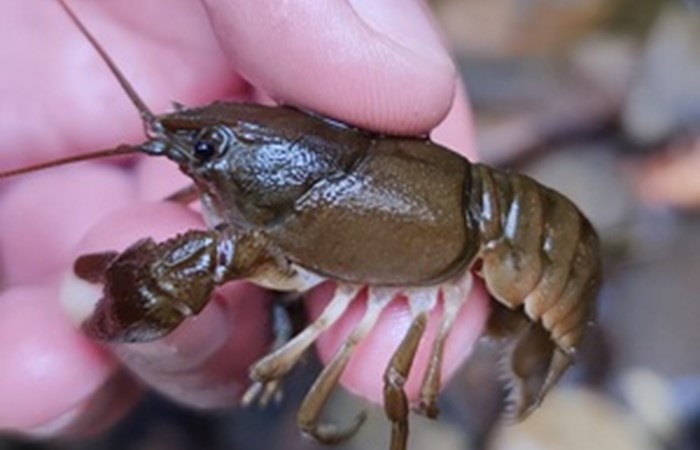Environment Agency

Environment Agency officers and partners in the Reviving Calderdales Rivers project made the fantastic find at Luddenden Brook. Its the first time they have been confirmed in that location for close to a decade.
White-clawed crayfish are the UKs only native, freshwater crayfish, and are most at risk from the American signal crayfish, which spread a fatal disease and compete for food.
The rare species plays a vital role in keeping our waterways clean and as a source of food for other native species, but have struggled to survive after the more aggressive signal crayfish population has taken hold.

Image shows one of the native white-clawed crayfish found in the brook.
Crayfish in very real danger of extinction
Dan Chadwick, Fisheries Technical Officer from the Environment Agency in Yorkshire, said:
Were delighted with this discovery. The white-clawed crayfish is in very real danger of disappearing from the UK so to confirm that a population we thought was lost is flourishing is exciting.
Well be working with partners including Yorkshire Wildlife Trust, Calderdale Council and Calder Rivers Trust to create better habitats and ensure this rare species can survive and thrive. It gives us real hope that there might be further populations in the Calder river catchment.
The signal crayfish, which originates from America, was introduced in the 1970s. It is bigger, more aggressive and out-competes the native white-clawed crayfish. They also carry a fungal disease known as crayfish plague, which is fatal to the native species. They burrow into banksides, causing increased siltation of watercourses which can smother river beds.
Populations of signal crayfish do exist in the main River Calder, but several weirs on Luddenden Brook isolate and protect the endangered white claw species from them. The Environment Agency is now calling on people to Check, Clean, Dry their clothing and equipment after visiting local rivers in the Calder catchment to avoid transferring the invasive species and the crayfish plague into the brook and risking harm to the white claw population.
River users should Check, Clean, Dry
Tim Selway, Environment Agency Biodiversity Technical Officer, said:
We want to do all we can to protect this special species so are calling on people to take extra care and make sure they are not moving crayfish from where they have been found.
Signal crayfish have rapidly spread across the country and moving just one into a river can wipe out an entire population of the white-clawed species, killing hundreds of thousands of them. And once the invasive signal becomes established in a river there is currently no way to get rid of them.
Elliot Baxendale from Yorkshire Wildlife Trust added:
Through partnership work its fantastic to see the rediscovery of the white-clawed crayfish in Luddenden Brook. This endangered species needs all the help that it can get and this can be as little as following the Check, Clean, Dry guidance to help ensure their survival in our shared interconnected eco systems.
If you see any crayfish, alive or dead, leave it where it is and report it immediately to the Environment Agency on 0800 807060. If possible, take close-up photos of the crayfish to help identify the species. It is illegal to handle or remove crayfish from the water without the correct licences.
More information can be found on the Invas
Related Articles
Comments
Write a Comment
Ministerial Departmental News
- PM's Office, 10 Downing Street
- Cabinet Office
- Department for Business, Innovation and Skills
- Department for Communities and Local Government
- Department for Culture, Media and Sport
- Department for Education
- Department for Environment, Food and Rural Affairs
- Department for International Development
- Department for Transport
- Department for Work and Pensions
- Department of Energy and Climate Change
- Department of Health
- Foreign and Commonwealth Office
- HM Treasury
- Home Office
- Ministry of Defence
- Ministry of Justice
- Northern Ireland Office
- Scotland Office
- Wales Office
- See all departments
